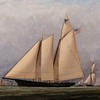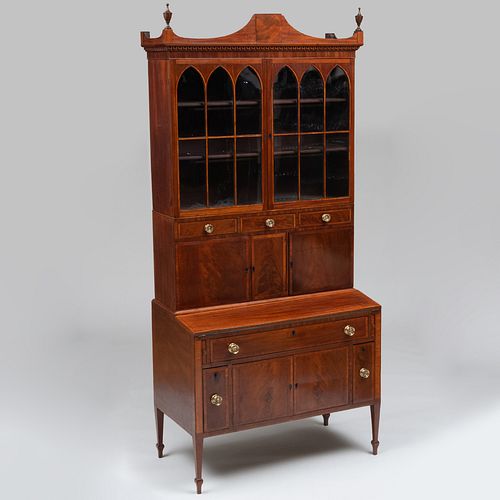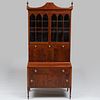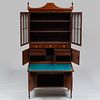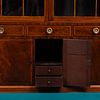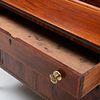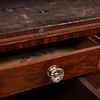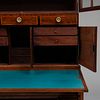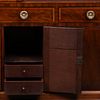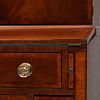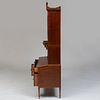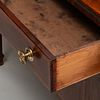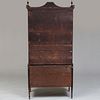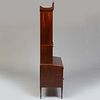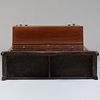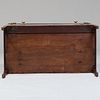Fine Federal Inlaid Mahogany Secretary, Possibly Seymour, North Shore of Massachusetts
Bid Increments
| Price | Bid Increment |
|---|---|
| $0 | $25 |
| $200 | $50 |
| $500 | $100 |
| $3,000 | $250 |
| $5,000 | $500 |
| $10,000 | $1,000 |
| $30,000 | $2,500 |
| $100,000 | $5,000 |
In three parts.
7 ft. 4 1/2 in. x 40 x 21 in.
Note: This secretary is an early example of the Northeastern Massachusetts style and possibly attributed to John and Thomas Seymour. The style was prevalent in and around Boston between 1790 and 1815. English émigrés John Seymour and his son, Thomas Seymour, elevated the style of cabinetmaking in the Boston area and popularized many of the notable features of the Federal period, inspired by classical styles. The design principles and features of furniture made by John and Thomas Seymour were most recently examined and catalogued in Robert D. Mussey, Jr.’s The Furniture Masterworks of John & Thomas Seymour (Salem, Massachusetts: Peabody Essex Museum distributed by University Press of New England, 2003).
While simple in its rectangular form, this and other case pieces by the Seymours were elevated in design through the use of highly figured veneers, inlay and intricate crossbanding. The stringing design on the front edge of the fall-front is common among Lady’s tambour secretaries attributed to the Seymours. The bookcase doors are a classical example of pointed Gothic arches, seen on many similar bookcases of the period. The upper leg blocks of this piece are veneered with highly figured birds eye maple which provides an elegant contrast from the surrounding mahogany.
In addition to the stringing on the fall-front edge, other features such as the rectangular cornice and urn finials, square tapered legs terminating in spade, or therm, feet, and contrasting and highly figured veneers, are similar styles found on an example attributed to Seymour in Robert Mussey's book (Mussey, p. 173, no. 19).
Certain aspects of construction on the Seymour's case pieces are indicators of their background as English cabinetmakers and joiners. One principal feature of their construction was the use of double mortises and tenons (Mussey, p. 119). While not always visible, this feature can be seen on this secretary on the lower case where the bottom traversing rail joins the sides of the case. A double mortise and tenon joint is also found joining the traversing rail of the drawer below the fall-front to the rails which divide the bottle drawers from the cabinet doors on the lower case.
Another common feature found on furniture attributed to the Seymours, is inscriptions in pencil, chalk or scratched numbers in various places on case furniture (Mussey, p 117). The three frieze drawers on this secretary are all inscribed with pencil in order from numbers 1-3 on the backs. All but drawer 1 are numbered on the drawer bottoms as well, inscribed N1, N2 and N3, respectively. Each drawer also has two pencil inscriptions ^ indicating the proper direction. The letter “N”s on each drawer are similar in style to one illustrated in Mussey's Masterworks (p. 117, fig. 5.49). Mussey describes the Seymour "N" as having "sharp peaks at the upper and lower ends or, more frequently, rounded looped ends" (Mussey, p.117). The inscribed letters on these drawers match this description.
The aesthetic features of this secretary as well as details in its construction, are all in-line with the expected forms of this period. If a definitive attribution to the Seymour workshop cannot be made, it is most certainly within the "School of Seymour." As Mussey describes in his book, the father and son duo were "influential in elevating the quality and standards of construction of the high-end furniture produced in all the shops in Boston" (Mussey, p. 132). This secretary is such an example of the refinement of technique and decoration seen beginning in the 1790s.
Condition
In good, restored condition with later finials, and fitted with two shelves in the upper section. A small triangular patch on the left lower hinged panel. The right-side door replaced. Minor veneer and string banding losses. Expected nicks, age splits and wear throughout. Ink staining and a lock plate missing on the long drawer of the lower section and on the bottom door. The escutcheons later ebonized. Slight staining on the baize writing surface, and the brass pulls on the supports below are added later. Two lower drawers fitted with compartments. Structurally sound, fine quality.
Not withstanding this report or any discussion concerning condition of a lot, all lots are offered and sold "as is" in accordance with our conditions of sale.
Available payment options
Collection from Stair We are open for pickups Monday through Friday, from 9:30am to 12pm and again from 1pm to 4:30pm. Please call us at 518-751-1000 to schedule collection. We ask that you collect your items or make collection arrangements within 10 days of your purchase. We suggest requesting a quote for packing and shipping prior to bidding on an item, as you will be responsible for collection or shipping if you are the successful bidder. Below is a list of shippers our clients use on a regular basis, but feel free to use your shipper of choice. For smaller items that can be boxed and shipped: UPS Store #5539 160 Fairview Avenue Hudson, New York 12534 T: 518.828.8777 F: 518.822.8727 E: store5539@theupsstore.com For furniture and other large items: Meticulous Inc. T: 845.256.7047 F: 845.256.7039 E: meticulousmovers@live.com Sure Express 1-800-335-9996 judy@sureexpress.com Worldwide Shipping: James Bourlet, Inc. T: 718.392.9770 F: 718.392.2470 www.bourlet.org Cadogan Tate Fine Art Worldwide Fine Art Logistics T: 718.706.7999 F: 718.707.2847 E: fineartny@cadogantate.com www.cadogantate.com Gander & White Shipping T: 718.784.8444 F: 718.784.9337 www.ganderandwhite.com Plycon Transportation Group T: 631.269.7000 F: 631.269.7088 www.plycongroup.com
